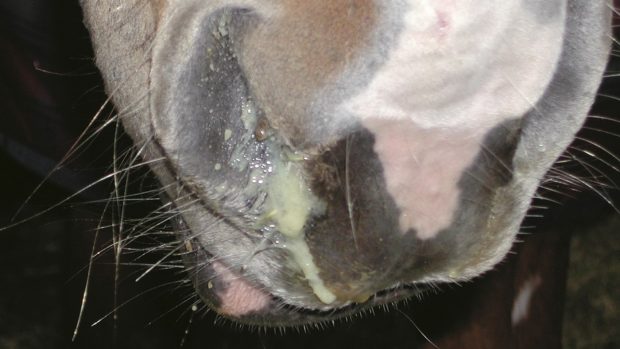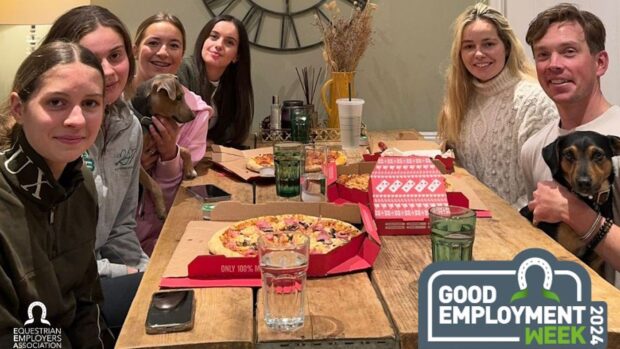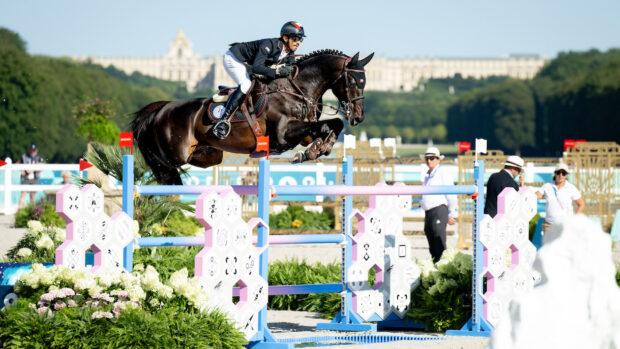Irish Olympic event rider Eric Smiley’s new book Two Brains One Aim, written with freelance journalist Ellie Hughes, is launched today (4 February) at the International Eventing Forum.
In this extract, he discusses how to avoid ending up with the wrong horse — and what to do if it happens.
There are many reasons why we end up with the horses we do. “He was cheap!” or “I bred him,” are among the common ones. It is our decision to own a horse: we do not have to; we could be doing something else. But the fact we choose riding as a hobby gives us the right to choose the partner we share it with. This quickly becomes a very emotive subject and one that I am often advised not to comment on, but I feel it is important to address, not least for the welfare of the horse.
As a coach, I do not always have the choice of whom I teach. People I do not know book lessons, sign up for clinics, and join my classes. The uncertainty of who turns up is part of the fun and challenge of coaching. It stimulates my skills to try and give riders fun and education in the time available, hoping that they go home feeling good about what has happened.
However, there are times that this is simply not possible because of the makeup of the combination. Turning people away is not always an option, so I have battled through lessons trying to keep people safe and make progress, while, at the same time, trying to give my full attention to others in the group. Throughout, I am wondering what I say to the rider at the end. What words of encouragement or comfort can I give and, at the same time, be honest? Do I need to get involved? Will it make any difference? It is a tricky dilemma.
My concern is, first, for the safety of the rider, and then for the welfare of the horse.
In these situations I ask myself whether it is the partnership that does not work, or the horse or the rider? Where does the blame lie? Sometimes it is neither side’s fault.
Sometimes the rider is not up to the task and may never be, but there are also cases where the horse is neither trainable nor safe. These horses need professional help and have no place in the hands of an amateur rider.
All too often, I have riders return to my clinics with a horse that is unsuitable, thinking that I can help them, seeking my opinion or confirmation that “he’s getting better.” In the interim 12 months, the horse has cost them 10 times what they paid for it and they have had a miserable time. I ask myself, what is the point?
I can remember at one of my clinics watching a horse reluctantly jump onto a bank. And there he stood, and stood, and stood. An hour and a half later he was still there. I advised his rider that he might not be a suitable cross-country horse.
On two occasions I have advised that the horse in question should never be ridden again—once for a horse that went over backward twice with his rider (who was not to blame), and once for a horse that bolted dangerously (also through no fault of his rider). Neither horse had apparent reason to do what he did. Sometimes, horses are just not suitable to become nice riding horses.
Ex-racehorses can be a good example. I love thoroughbreds and always have. Their extra bit of “something” appeals to me, especially for eventing. However, it is important to remember that these animals have been taught in a different way. Their life from an early, impressionable age has been to run. The aids they have learned and the life they have led is not always conducive — or easy — to change. Some ex-racehorses are retrainable and there are many stories of horses that have succeeded in other disciplines, but — and it is a very big but — this has been achieved through skilled training and careful, knowledgeable handling. This is often a professional’s task. Even the quiet, easy Thoroughbred off the track will still have all the training issues associated with a young horse, with the added complication of having to retrain the conditioned reflexes that he brings with it.
People often need help and advice to find the right equine partner, preferably from someone who knows the individuals and what they need in a horse. Be prepared for some blunt advice and use it constructively. It is pertinent to remember that the horse has little choice in his partner. He can’t say no to you.
Sometimes it is painful for me to watch and not be able to do anything except applaud a horse’s good nature and generosity. There are welfare issues that concern me and, at times, people need these pointed out to them so they can take responsibility and address them. Remember, the horse has no say.
How to avoid an inappropriate partner
These are the questions for riders to ask themselves:
➤ How good a rider are you? It is important to be critically analytical. This is difficult to do, but necessary.
➤ How much time and what facilities do you have?
➤ What do you want the horse for?
➤ If he is cheap, why? Beware!
➤ What breed of horse will suit your needs?
➤ Is size important?
➤ Age versus suitability: which is more important?
➤ Body versus mind: be aware of the beautiful-looking but unforgiving horse.
Article continues below…
You might also be interested in:

12 training principles from Olympic medallist and former European champion Tina Cook
Tina Cook shares her thoughts on goals, jumping out of walk and teaching horses right and wrong

Subscribe to Horse & Hound magazine today – and enjoy unlimited website access all year round

19 tips from top eventers on how to nail your jumping warm-up and aid success in the ring
Here’s some top tips from Tom McEwen and Richard Jones on how to best warm your horse or pony up,
What to do with an inappropriate partner:
➤ Get a quick divorce — do not prolong the agony. Keeping an unsuitable horse will only cost money and cause heartache. Remember, riding is supposed to be pleasurable and there are other horses out there.
➤ The best way to get out is to consult people in the trade. Coaches and local dealers are good starting points.
➤ When the horse is dangerous do not discount euthanasia. It may be a kindness in the long term. If a horse is not to be ridden again, I believe we have a “responsibility of care” for that animal, as we do for other animals, like cats and dogs. I do not think that it is ethical to abdicate our responsibility by not making the right decision. I have heard of horses being let loose in the wild to fend for themselves, and horses being left in one of the less discerning homes for retired horses, waiting to die. We have a moral obligation to do the right thing by the animals that we are responsible for.
Price: Two Brains One Aim can be purchased for £19.95 from Quiller Publishing. It is also available to buy via Amazon.
Published by: Quiller Publishing, 2019
For all the latest news analysis, competition reports, interviews, features and much more, don’t miss Horse & Hound magazine, on sale every Thursday.




